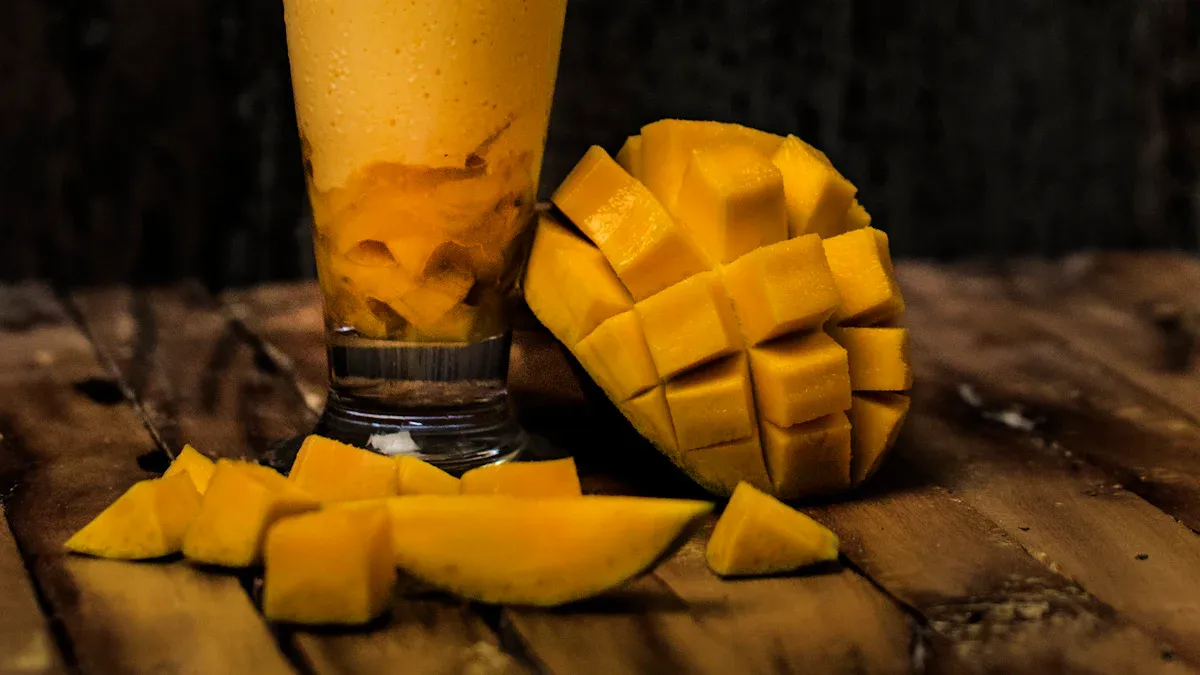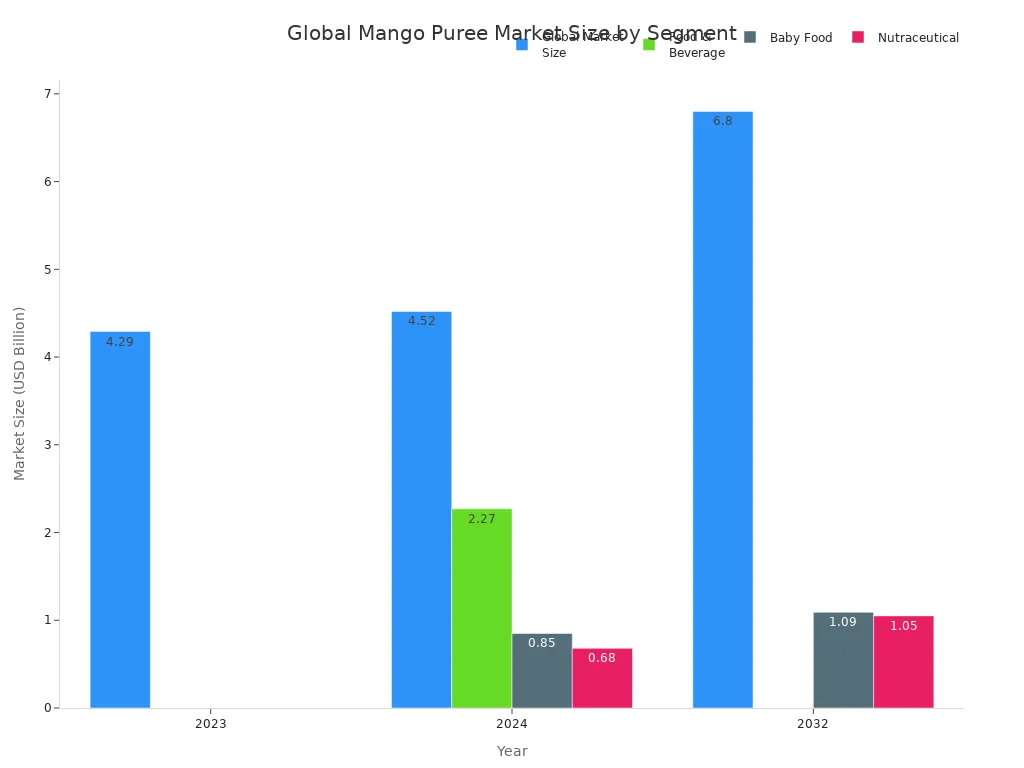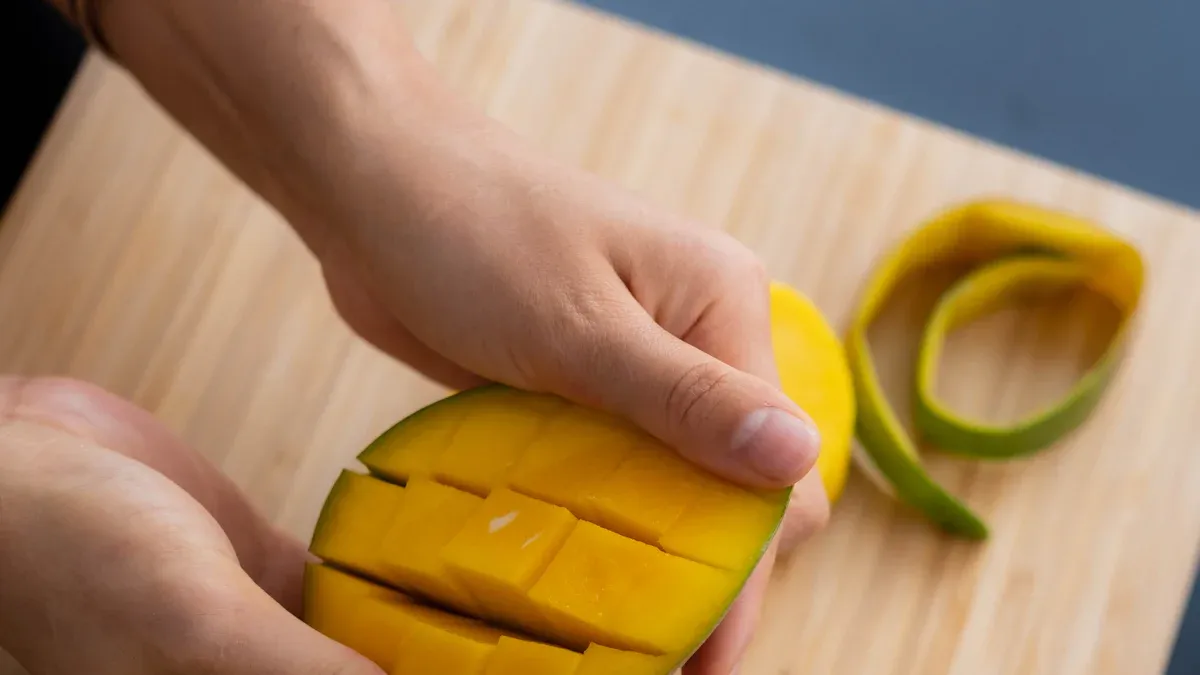Views: 0 Author: Site Editor Publish Time: 2025-08-12 Origin: Site









When you eat a spoonful of mango purée, you taste sweet, ripe mango. It feels smooth and creamy in your mouth. People use mango purée in smoothies, desserts, and baby food. It is also used in products like juices and ice cream. There are two main types of mango purée. One is concentrated mango puree. The other is non-concentrated mango purée. Concentrated mango puree has less water. It feels thicker and tastes stronger. Non-concentrated mango purée keeps more of the fruit’s real flavor and texture.
Characteristic | Concentrated Mango Puree | Non-Concentrated Mango Purée |
|---|---|---|
Water Content | Very low | High |
Flavor Intensity | Strong | Natural |
Usage | Beverages, bakery, etc. | Baby foods, sauces, etc. |
You might be surprised by how much people like mango purée. The world market for mango purée grows bigger every year. It is now worth billions of dollars. Look at this chart to see how much people want mango purée around the world:

Pick ripe mangoes for the best taste and smooth feel when making mango puree at home. Blend mango pieces until they are smooth. Strain the puree if you want it extra creamy. Keep the puree in containers that close tightly. Put them in the fridge or freezer. Add honey, lime juice, or spices like cardamom to make your mango puree taste better. Factories make industrial mango puree with big machines. It lasts longer and always has the same quality. Mango puree is healthy and can be used in many ways. It is great for smoothies, desserts, baby food, and other foods.

You want to make mango puree at home? You need just a few things. Start with fresh mango. Choose ripe fruit for the best flavor. You can use Tommy Atkins, Honey (Ataulfo), Kent, Keitt, Francis, Haden, or Alphonso mangoes. Each variety tastes a little different. Check out this table to help you pick:
Mango Variety | Flavor Profile Description | Texture/Other Notes |
|---|---|---|
Tommy Atkins | Tart, tropical hints | Fibrous texture |
Honey (Ataulfo) | Sweet, peachy aroma | Vibrant yellow skin |
Kent | Juicy, sweet, tropical aroma | Bright yellow flesh |
Keitt | Very sweet, firm, juicy | Green blushing skin |
Francis | Sweet, fruity, peachy aroma | Dreamy aroma of peaches |
Haden | Sweet, sour, hint of bitter tropical | Colorful skin |
Alphonso | Rich, creamy, sweet | Firm flesh |
You also need a blender, food processor, or immersion blender. For extra smoothness, grab a sieve. If you want to boost the flavor, keep honey, lime juice, or spices nearby.
Let’s walk through how to make mango puree. This easy recipe takes about 10–15 minutes from start to finish.
Wash fresh mangoes well to remove dirt.
Peel the mango and cut the flesh away from the pit.
Dice the mango into chunks.
Place the mango pieces in your blender or food processor.
Blend until smooth. If the puree is too thick, add a splash of water.
For extra smooth mango purée, strain it through a sieve.
Store your fresh mango puree in a clean, airtight container. Refrigerate for up to one week or freeze in ice cube trays for longer storage.
Tip: Use ripe mango for the best texture and sweetness. Frozen mango works too if you thaw it first.
You can make your basic mango purée recipe even better. Try adding honey or maple syrup for sweetness. Squeeze in lime juice for a tangy twist. Want a tropical vibe? Mix in coconut milk. For easy recipes like mango lassi or smoothies, add yogurt or vanilla. If you love spice, toss in a pinch of cardamom or ginger.
Recipe Type | Popular Add-ins for Mango Purée Flavor Enhancement |
|---|---|
Mango Lassi | Yogurt, milk, honey, cardamom |
Mango Smoothie | Milk, yogurt, vanilla, ice cubes |
Mango Salsa | Onion, tomato, cilantro, lime juice |
Mango Chutney | Vinegar, ginger, cumin, red pepper flakes |
You can use your homemade puree in desserts, drinks, or sauces. This basic mango purée recipe is an easy recipe you’ll want to make again and again. Now you know how to make mango purée at home!
Have you ever thought about how companies make mango puree in huge amounts? Big factories make lots of mango puree every day. They use tons of mangoes. India makes and sells the most mango puree in the world. Mexico, Brazil, and Peru also help a lot, especially for the U.S. market. Thailand, Vietnam, and the Philippines are making more mango puree now. Some African countries like Kenya and Egypt are building new places to make and sell mango puree.
Here are the main countries that make mango puree:
India: Makes and sells the most mango puree
Mexico, Brazil, Peru: Important for North and Latin America
Thailand, Vietnam, Philippines: Making more in Asia-Pacific
Kenya, Ghana, Egypt: Growing mango puree for export
Region/Country | Production Volume (metric tons) | Export Volume (metric tons) | Key Notes |
|---|---|---|---|
India | 654,000 | 384,000 | Biggest maker and seller; sends puree to Middle East and Europe; invests a lot |
Thailand, Vietnam, Philippines | 98,000 (combined) | N/A | Important makers in Asia-Pacific; building more factories |
Mexico | N/A | Part of 274,000 (Latin America total) | More people in Mexico buy and sell mango puree, especially to North America |
Peru | N/A | Part of 274,000 (Latin America total) | Peru makes a lot and sells to other countries |
Kenya, Ghana | 67,000 (combined) | 41% of production | African countries send some mango puree to the EU |
UAE, Saudi Arabia | N/A | Major importers | These countries buy mango puree but do not make much |
Europe | N/A | Heavy importer | Europe buys a lot of mango puree and likes organic, but does not make much |

Making mango puree in a factory is very different from making it at home. Factories use machines to do everything fast. They start with fresh mango or sometimes mango concentrate. Workers check if the mangoes are ripe and good. Machines wash the mangoes, peel them, and take out the pit. Pulping machines crush the mango to make it smooth.
Here are the steps factories use:
Machines clean mangoes and remove dirt and chemicals.
Peeling and pulping machines take off skin and pit, then crush mango.
Preheating stops browning in the mango puree.
Refining machines make the puree smooth and even.
Concentration machines make the puree thicker for some products.
Blending machines add sugar, citric acid, or ascorbic acid for taste and to keep it fresh.
Degassing and homogenization take out bubbles and make the texture the same.
Sterilization kills germs and keeps the puree safe.
Filling machines put the puree into bottles or cans.
Factories check the quality all the time. Workers test sweetness and ripeness. Machines watch temperature and cleanliness. Industrial mango puree has preservatives like citric acid and sodium benzoate. These help the mango puree last longer. Labels show what is inside and how to store it. Companies follow food safety rules like HACCP and ISO 22000.
Tip: Industrial mango puree stays fresh much longer than homemade because of these steps and added ingredients.
Making mango puree at home is simple. You only need a few mangoes and basic tools. You might use one or two mangoes for a snack or drink. Factories make much more mango puree every day. They use machines to wash, peel, and blend the fruit. Big batches of mango puree are made for shipping. Factories use special machines and computers. This helps them fill thousands of jars or cans at once.
Let’s see how cost and equipment are different at home and in factories. At home, you just need a blender, knife, and maybe a sieve. Factories have special machines for each step. Here’s a table to show the differences:
Aspect | Homemade/Small-Scale Production | Industrial-Scale Production |
|---|---|---|
Machinery Type | Basic kitchen tools | Full processing lines with automation |
Throughput & Scalability | Low, just a few mangoes | High, thousands of mangoes |
Cost per Unit | Higher, less efficient | Lower, spread over large batches |
Initial Investment | Low | High, needs big machines |
Quality & Consistency | Changes each time | Very consistent |
You spend less money at home, but each batch costs more. Factories pay a lot at first, but save money by making a lot at once.
Quality depends on how you pick and blend your mangoes. Always choose ripe mangoes for the best taste and texture. At home, you can change the flavor and how smooth it is. You can blend longer or strain it for a creamy puree. Factories use machines to keep every batch the same. They use heat and special ingredients to stop it from spoiling.
Here’s a quick look at shelf life:
Product Type | Shelf Life (Unopened) | Shelf Life (Opened) |
|---|---|---|
Homemade mango puree | 2–7 days (refrigerated) | 2–3 days (refrigerated) |
Industrial mango purée (canned/aseptic) | 12–18 months | 7 days (refrigerated) |
Industrial mango puree lasts much longer because of packaging and added ingredients. Homemade mango puree tastes fresh but does not last long.
Tip: For a creamy puree, blend your mango well and strain it. Add lime juice or a little spice for extra flavor.
Ripe mangoes give the best taste.
Heat can change the color and feel.
Packaging keeps out air and light.
Adding juices or spices can make it taste better.
Factories use machines to peel, so their puree is always the same.
You control the taste at home, but factories make puree that lasts longer and is always the same.

Mango puree can be used in many yummy foods. You can add it to appetizers, desserts, drinks, and sauces. Try putting mango puree in a smoothie for a tropical taste. Mix it into yogurt or pour it over pancakes. Many people use mango puree for baby food because it is smooth and sweet.
Here’s a table with some well-known dishes from different places that use mango puree:
Dish Name | Culinary Application | Cuisine |
|---|---|---|
Mango Manchego Stuffed Jalapenos | Appetizer | Spanish |
Mango Habanero Salsa | Appetizer/Salsa | Mexican |
Nashville Hot Chicken Sandwich | Relish for Lunch/Dinner | American |
Thai-Inspired Coconut-Pandan Rice Pudding | Dessert | Thai |
Lime Possets with Mango Fruit Salad | Dessert | British/European |
Mango Icebox Cake | Dessert | Italian/European |
Mango Habanero Barbecue Sauce | Sauce | Various |
Mango Shandy with Chile, Ginger, and Lime | Drink | Various |
Mango puree tastes great and is healthy, too! Look at these health benefits:
Nutritional Benefit | Explanation |
|---|---|
Rich in Nutrients | Full of vitamins C, A, E, potassium, and folate. |
Antioxidant Powerhouse | Helps your body fight stress and swelling. |
Digestive Health | Fiber helps your stomach work well. |
Eye Health | Beta-carotene is good for your eyes. |
Skin Radiance | Vitamin C helps your skin look bright. |
Factories put mango puree in lots of foods you buy. You can find it in juices, smoothies, ice cream, yogurt, and bakery treats. Big companies like Coca Cola and Starbucks use mango puree in their drinks and desserts. Mango puree is also important in baby food and fruit snacks.
Here’s a table showing where mango puree is used in the food business:
Industrial Use Category | Specific Applications / Examples |
|---|---|
Beverages | Juices, smoothies, kids’ drinks, jams |
Dairy & Frozen Desserts | Ice cream, flavored yogurt, fruit yogurts |
Bakery & Snacks | Bakery fillings, puddings |
Infant Foods | Baby food, fruit meals for kids |
Confectionery & Others | Jams, fruit cheese, flavoring, candy |
Organic Segment | Products made for health |
To keep mango puree fresh, store it in the fridge for up to 3 days. If you want to keep it longer, freeze it in small amounts. Use airtight containers, ice cube trays, or freezer bags. Always use clean, dry containers and close them tightly. Write the date on each container so you remember when you made it. Use a clean spoon every time you take some out to keep it safe.
Tip: Freezing mango puree keeps its taste and vitamins for months. Do not refreeze mango puree after it has thawed or it might spoil.
Now you know how to make mango purée at home. You also learned how factories make it in big amounts. You can blend ripe mangoes in your kitchen. Or you can watch machines make lots of mango puree. Mango puree adds taste to many foods. Sometimes it is hard to keep it fresh and safe. You should use clean tools and store it well. People use mango purée in smoothies, desserts, and baby food. More people want healthy and natural foods now. You can find mango puree in many new ways!
Some common problems are:
Keeping the taste and texture right
Stopping it from spoiling or getting dirty
Handling changes when mangoes are not in season
Try making mango purée at home or look for new kinds at the store. Mango puree will be even more popular in the future!
You want a mango that feels soft when you press it gently. The skin should look bright and smell sweet near the stem. If it feels hard, let it ripen at room temperature.
Yes, you can! Pour the puree into ice cube trays or freezer-safe bags. Label the date. Frozen mango puree keeps its flavor for up to six months.
Try adding a little honey or sugar. You can also mix in a splash of orange juice. These tricks help balance the sour taste and make your puree sweeter.
Mango puree is a great first food for babies. Make sure you use ripe mangoes and blend until smooth. Don’t add sugar, salt, or spices for babies under one year old.
You can use canned mangoes if you don’t have fresh ones. Drain the syrup first. Rinse the pieces to remove extra sugar. Blend until smooth. The taste may be a bit sweeter than fresh mango puree.